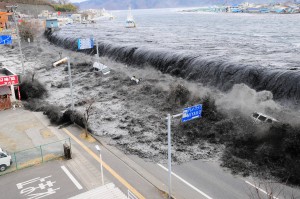Ahead of the wave
Bump a glass and any water inside might slop over the side. Splash in the bathtub and waves slosh. Toss a rock into a pond and ripples move outward in expanding rings. In each case, the water moves in waves. Those waves carry energy. And the more energy that gets added to a watery environment, the more powerful the waves may become.
Now imagine an undersea earthquake and the tremendous amount of energy it can transfer to the ocean. That is because the movement of the Earth’s crust can shift huge volumes of water, unleashing a parade of great and powerful waves. The water races away at speeds up to 800 kilometers (500 miles) per hour, or as fast as a jet plane.
Eventually those waves reach shallow water. They slow down and swell, sometimes as high as a 10-story building. When the waves eventually crash onto land, they can swamp hundreds of kilometers (miles) of shoreline. They may snap trees like twigs, collapse office buildings and sweep away cars. Among nature’s most powerful forces of destruction, these waves are called tsunamis (tzu NAAM eez). The Japanese term means “harbor wave.”
Read more at Science News for Kids.
